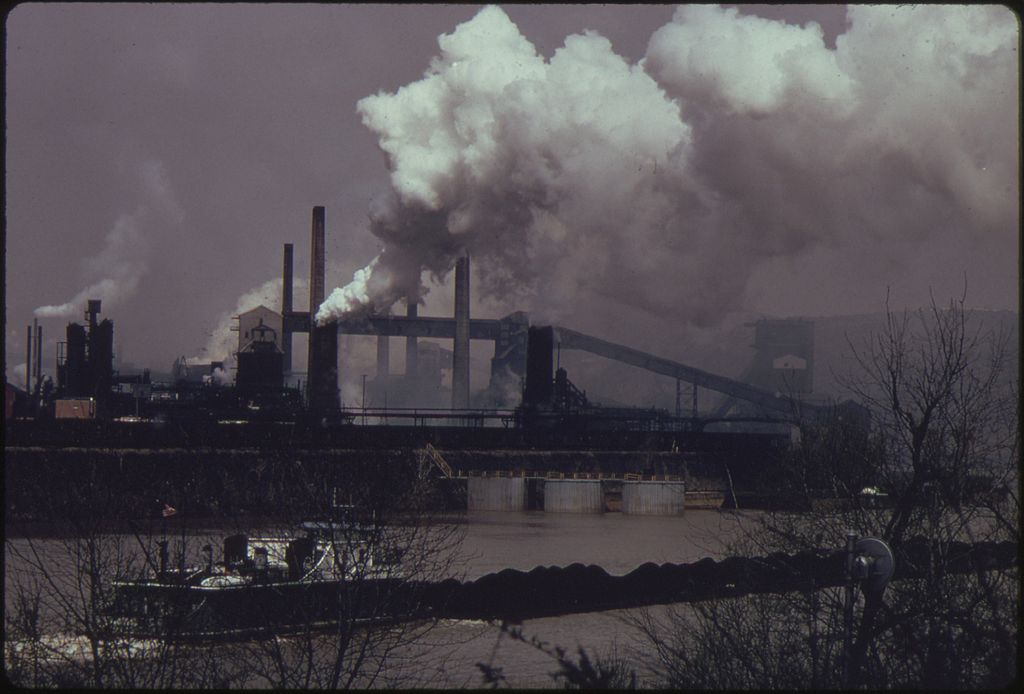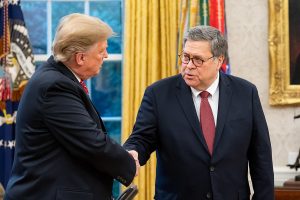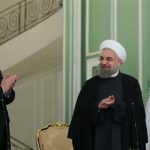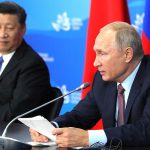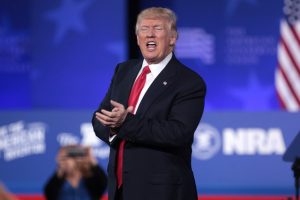by John Feffer
In Pittsburgh, where I worked for two months in 1986, I breathed clean air.
The steel mills along the rivers leading into town were mottled with rust. The Steelers still played in Three Rivers Stadium in those days, but it was the glass towers of PPG Plaza — originally the headquarters of Pittsburgh Plate Glass Company — that symbolized the city’s future: clean, energy-efficient, and sparkling in the sunlight.
All of this was a far cry from the 1940s, when sunlight rarely penetrated the dome of smog over Pittsburgh, so much so that the streetlights stayed on during the day to help people navigate the gloom. Pittsburghers proudly described their city as “hell with the lid taken off.” Smog, after all, meant jobs, and many even believed that it was good for the lungs.
In Tokyo, where I lived for three years beginning in 1998, I breathed clean air.
The city was a marvel of modernity with its huge neon billboards, monumental skyscrapers, and well-groomed parks full of cherry trees. But not that long before, the air quality in Tokyo had been so bad that pedestrians suddenly overcome by near-asphyxiation could, in desperation, get oxygen from vending machines on the streets. The impending arrival of the Olympics in 1964 helped to persuade city authorities to do something about the environmental damage before it made Japan’s capital completely unlivable.
Every city, indeed virtually every place touched by modern hands, conceals two contrary pasts.
The first is a prelapsarian memory of jungle and forest and rivers teeming with fish that existed before the advent of humans and our disfigurements of farming and manufacture. The second is the period of peak pollution, when the production of things trumped all other considerations, whether the natural environment, human health, or even common sense.
Modern man didn’t invent the exhaustion of the natural world. Other cultures — Easter Islanders, Mayans — farmed themselves to the point of extinction. But “civilized man” has taken things to the extreme.
The evidence of Pittsburgh or Tokyo today would suggest that we have avoided the fate of the hapless Eastern Islanders, who left behind nothing but an array of enormous heads as evidence of their misspent energies. Environmentalists might beg to differ, pointing to India, where air pollution is the country’s second biggest killer, or China, where air pollution is responsible for one out of three deaths. Indeed, the same “air stations” once common on Tokyo streets can now be found in China’s most polluted cities. The club of industrialized nations seems to require all aspiring members to go through an identical hazing process.
It’s likely that China and India will go through the same “greening” as earlier industrializers. Economies become “post-industrial,” wealthier societies produce fewer children, and “quality of life” becomes more important than owning more and more things. This virtuous circle for cities can become win-win solutions for countries and for the planet as a whole.
But just when you might persuade yourself to be optimistic about this inevitable march toward environmental sustainability, along comes global warming.
The clean skies over Pittsburgh are deceptive. Gone are the most of the smog-belching factories, but Americans still own way too many cars, use way too many electronic gadgets, and live with an energy hog of a military that’s way too large. Industrialized countries, like the United States, emit just as much if not more carbon as late industrializers like India and China. As a country, the United States produces 14 percent of the world’s carbon dioxide emissions, putting it in the middle between China (29 percent) and India (about 7 percent). But in per-capita emissions, Americans produce double what Chinese do, and eight times the level of Indians.
Yes, the United States reduced overall greenhouse gas emissions by 7 percent since 2005, and other countries like Denmark and Uruguay have done a great deal better. But the overall temperature increases — with 2016 the hottest year on record — are not at all encouraging.
So, the world is caught between these two seemingly inexorable yet contrary trends. We are becoming greener, and we are becoming hotter. Optimists believe that the world will be saved by the economic determinism of the first trend: We will green ourselves out of the predicament. Pessimists believe that the world will be destroyed by the environmental determinism of the second trend: Humans have already plunged the planet into a destructive feedback loop.
Then there are those who believe that determined leadership one way or the other can make the difference.
And that’s where Donald Trump comes in. Not only does he not believe in climate change. He actually wants to bring Pittsburgh and the rest of the rust and coal-mining belt back to their glory days. Can one determined and willfully ignorant man both stem the green tide and push the world over the brink into ecocide?
What Trump Wants
In March, Donald Trump assembled a group of coal miners to serve as the backdrop to his signing of new executive orders on the environment. These directives allow coal mining to take place on federal lands, repeal several Obama-era environmental regulations, and in general prioritize jobs and “energy independence” over environmental considerations. Trump also wants a review of the Clean Power Plan, the Obama administration’s signature effort to reduce the U.S. carbon footprint.
As with Trump’s attempt to keep Muslims out of the country, his latest executive order will likely end up in court. After all, even the Clean Power Plan entered legal purgatory when 27 states filed suit to block implementation — and the Supreme Court last year suspended the act in a controversial 5-4 decision (the case is still tied up in the courts).
Trump’s move has naturally attracted the outrage of environmentalists. But he’s also going up against powerful businesses that continue to back Obama’s initiatives, including Staples and Levi Strauss. Even if the battle shifts to Congress, this kind of opposition would mean that extremists who’d like to declare that carbon dioxide is not a pollutant just wouldn’t have enough votes.
Trump’s move comes at the same time that the administration is attempting to gut the Environmental Protection Agency by cutting a quarter of its staff and eliminating 50 programs. The cuts would make it very difficult for the agency to ensure compliance with whatever regulations remain on the books, such as fuel efficiency standards for cars.
Even though Trump hasn’t formally signed the United States out of the Paris Accord on climate change — he promises to make a decision next month — the executive orders will, if successfully implemented, make it very difficult for the United States to meet its commitments under the agreement.
Trump has some powerful global allies in his effort to unwind international commitments. Vladimir Putin, who has a history of going back and forth on the issue of climate change, most recently argued that humans can’t stop global warming, only adapt to it. Adaptation, for Putin, means finding economic and geopolitical profit from all that melting ice up north — opening up areas for navigation, trade, and drilling. Expect Trump to make a similar set of arguments in the near future (Trump Resort Point Barrow?).
Much of the rest of the world, however, is appalled by Trump’s “America First” approach to global warming. The EU and Canada will continue with their already better-than-average policies. The bigger surprise is China, which is taking the exact opposite approach from Putin’s Russia: seeing geopolitical and economic advantage in a clean energy future. Back in the fall, one of China’s top climate change negotiators already anticipated how his country would benefit from Trump’s short-sighted efforts: “China’s influence and voice are likely to increase in global climate governance, which will then spill over into other areas of global governance and increase China’s global standing, power, and leadership.”
But there are also more immediate economic benefits for China, as John Light explains:
By 2020, the country hopes to get 15 percent of its energy from non-fossil fuel sources, a push that the government will fund with a $361 billion investment in renewables and nuclear energy that will create 13 million jobs for Chinese citizens.
The odds seem quite long for Donald Trump and his efforts to revive the “Satanic mills” of the industrial revolution that so poisoned Pittsburgh and its polluted cousins. No one believes that he can defy the laws of modern economics to resurrect the coal and steel industry any more than gold bugs can bring back the gold standard or the Amish can replace SUVs with horse and buggies. His efforts to gut environmental standards could indeed have some specific, short-term impact, but the courts, environmental groups, and community activists are likely to prevent him from doing the worst.
On climate change, Trump faces not only serious opposition from powerful institutions — and even he can’t call Staples part of the “deep state” — but from an international community that has achieved a rough consensus on the multiple benefits of reducing carbon emissions.
But these are very slender reasons for optimism.
Trump vs. the Ecosystem
Ecosystems can be quite resilient. They can maintain or regain equilibrium in the case of disruptive events, such as the extinction of a species. It all depends on how critical that species was in the complex interdependency within the ecosystem.
Ecosystems can also adjust to the introduction of invasive species. Honeybees were reintroduced into the United States in the 17th century, and the ecosystem not only adjusted to the newcomers but became dependent on them in a positive way.
On the whole, however, invasive species are bad news, as Nature explains:
Invasive species have contributed directly to the decline of 42 percent of the threatened and endangered species in the United States. The annual cost to the United States economy is estimated at $120 billion a year, with over 100 million acres (an area roughly the size of California) suffering from invasive plant infestations.
A new theory of Easter Island’s collapse, for instance, puts the blame on rats that stowed away on incoming canoes and ate through much of the island’s palm trees.
It’s been common to talk of Donald Trump as an outsider. Perhaps it would be more accurate to call him an invasive species. He is non-native to Washington, DC. He is a super-predator introduced into the international community. His supporters think of him as the Great Pollinator, an example of a positive invasive like the honeybee whose transactional politics will make America bloom again.
But the odds of that are next to nothing. In reality, Donald Trump is kudzu. He is out to strangle anything and everything in his path.
If the global ecosystem were in good shape, it could deal with an invasive species like Donald Trump. But the ecosystem has been compromised by any number of factors. The global economy remains addicted to fossil fuels and over-consumption more generally. We’ve seen massive species die-offs. And the human population has yet to plateau.
The bottom line: We’re not getting green enough, fast enough, to made a big enough difference on the seemingly inexorable increase in global temperatures. By 2016, the world desperately needed a game changer who could drain the swamp of Big Energy. Instead, it got a reverse game changer.
Trump will be a problem more for what he doesn’t do than what he does do. There will be significant opportunity costs connected with his failure to continue — much less improve upon — Obama-era initiatives. Those who anticipate that judicial and legislative institutions will block much of what Trump wants to do might be right.
But as Jeremy Brecher writes in his critically important new book, Against Doom: A Climate Insurgency Manual, it’s too late for politics as usual. It will take nothing less than “mass, global, nonviolent action to challenge the legitimacy of the public officials in the U.S. and elsewhere who are perpetrating climate destruction.”
That movement needs to begin here in the United States in stopping the kudzu known as Donald Trump — before he spreads out of control.
Reprinted, with permission, from Foreign Policy In Focus.

